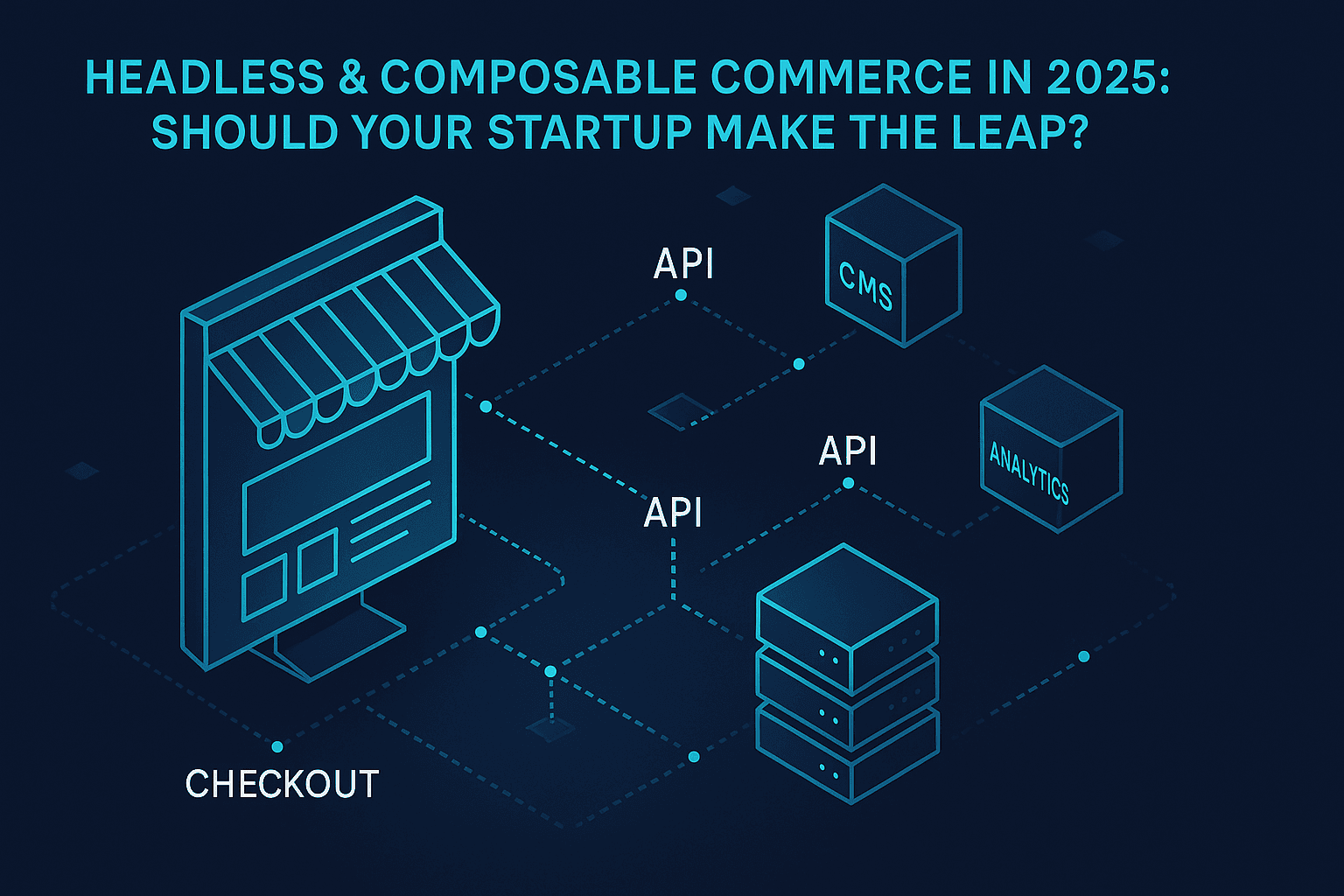Uncategorized
Headless & Composable Commerce in 2025: Should Your Startup Make the Leap?
Ronnie Nelson

1. Wait—Why Is Everyone Talking About This Now?
It’s on every trend list. “Headless” and “composable” topped Hygraph’s May roundup of 2025 e-commerce must-haves, right beside AI pick-and-pack robots. (hygraph.com)
Enterprise money is piling in. Visa’s new Intelligent Commerce platform lets AI agents comparison-shop, then call modular checkout APIs at lightning speed—proof that blue-chip brands are betting on modular stacks, not monoliths. (Reuters)
Tooling finally feels…sane. Shopify just pushed Hydrogen to React Router 7, trimming bundle size and adding first-class middleware; BigCommerce is marketing itself as “open SaaS, composable ready.” (Shopify, BigCommerce)
In short: the ecosystem matured while you were busy shipping holiday promos. Now the question isn’t “Is headless real?” but “Does it fit my stage?”
2. Two Buzzwords, One Minute
Term | TL;DR |
Headless commerce | Front end (storefront) and back end (catalog/checkout) are decoupled, talk via APIs. |
Composable commerce | You don’t just decouple once—you mix-and-match everything (CMS, search, payments) like LEGO bricks, swapping vendors at will. |
Think of headless as pulling the display off a cash register; composable is replacing each internal part with best-of-breed modules.
3. Who Actually Wins With Headless in 2025?
Good fit
DTC brands chasing sub-2-second mobile loads.
SaaS startups selling merch + subscriptions + gated content in one cart.
Marketplaces expanding into multiple regions/currencies faster than Shopify Markets can keep up.
Bad fit
One-product Shopify stores doing <$30k/mo and already at 90 % ad-spend burnout.
Side-hustle merch lines that don’t have—or want—engineering bandwidth.
If your biggest bottleneck is still “drive traffic,” keep the monolith. Headless solves traffic conversion, not traffic creation.
4. Payoffs You Actually Feel
Payoff | Why It Matters in 2025 |
Speed | Edge-rendered Next.js shops on Vercel routinely hit Lighthouse 95+. Lower CPCs follow. ( ) |
UX freedom | Want a 3-D configurator or shoppable video feed? No theme-editor hacks required. |
Omni-channel future-proofing | Pipe your catalog into TikTok Shop, in-car dashboards, or the Visa AI agent without rewriting templates. ( ) |
Vendor leverage | Swap Algolia for Meilisearch in a sprint, no replatform drama. |
5. The Gotchas (Read These Twice)
Dev horsepower goes up, not down. You’ll need React or Vue talent plus DevOps.
TCO surprises – hosting + CDN + “one tiny search API” can eclipse a Shopify Advanced plan fast.
More pieces, more blame-shifting. When checkout fails at 11 p.m. on Black Friday, five vendors may point at each other before someone fixes CORS.
Migration drag. Data modeling for products with 7-layer variants is rarely one-click. Budget weeks, not hours.
6. 2025 Cost Snapshot (Ballpark)
Item | Bootstrapped MVP | Funded Series A Store |
Front-end hosting (Vercel) | $20–$40/mo | $200–$600/mo (edge functions + image optim) |
Commerce back end (BigCommerce/Open SaaS or Shopify Plus API‐only) | $0–$500/mo | $2k–$3k/mo |
Search, CMS, reviews, etc. | $50/mo | $500–$1k/mo |
Total | ≈ $100–$600/mo | ≈ $3k–$5k/mo |
Add two FE dev salaries if you’re starting from scratch.
7. Tool Showdown: “Shopify Hydrogen vs. Next.js Shop”
Feature | Shopify Hydrogen | Next.js Shop on Vercel |
Data source | Shopify’s Storefront API only | Any platform—Commerce Layer, Medusa, BigCommerce |
Hosting feel | Deploy to Oxygen (Shopify’s edge) or any Node host | One-click Vercel with ISR & edge functions |
Checkout | Shopify secure checkout (same as online store) | Depends on your back end (Stripe, BigCommerce, custom) |
Dev curve | DSL-ish React helpers; opinionated | Pure Next.js; BYO components |
When to pick | You’re already on Shopify Plus, want incremental headless | You need multi-source content, or you dislike Shopify’s checkout fees |
8. Decision Matrix (Print This)
Question | If “yes” lean headless/composable | If “no” stay monolith |
1. Do we need site-wide sub-2-second LCP? | ✔ | |
2. Will we add new channels (mobile app, kiosks) this year? | ✔ | |
3. Do we have in-house React talent or budget for an agency? | ✔ | |
4. Is our catalog < 5k SKUs with simple variants? | ✔ | |
5. Is our current store conversion rate below 2 % mainly due to speed? | ✔ |
Three or more checks on the left → explore a pilot. Otherwise, squeeze more juice from your current platform first.
9. How to Test the Waters in Two Sprints
Spin up a proof-of-concept storefront on Vercel’s Next.js Commerce template.
Map just one category (e.g., best-selling SKUs) via Shopify’s Storefront API or BigCommerce’s GraphQL.
Benchmark speed and conversion against your live theme using an A/B flag.
Interview customers—does the new UX feel snappier, or is it “meh”?
Project 12-month ROI: extra margin from conversion gains minus projected stack cost. Decide.
Total cost: one dev, two weeks, $0 in platform fees.
10. Parting Thoughts
Headless and composable commerce aren’t magic—they’re power tools. In 2025 the ecosystem is mature enough that a small, focused team can wield them, but only if the business case is crystal clear. Kick the tires with a micro-storefront, measure real numbers, then choose—boldly or not at all.
Need on-brand visuals for that new decoupled storefront? Our BrandByte AI brand-kit generator spits out logos, colors, and font stacks in minutes—so your shiny, fast checkout looks as polished as it feels.
Happy building, and may your APIs stay under 200 ms.
